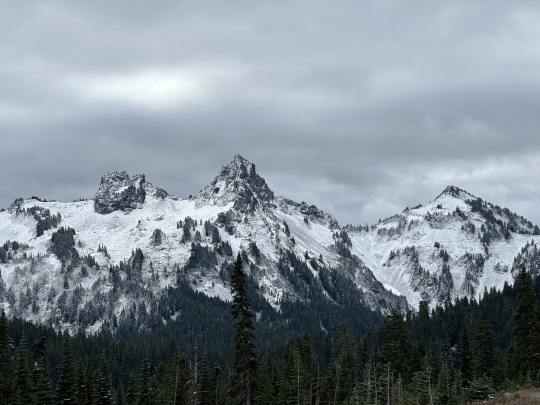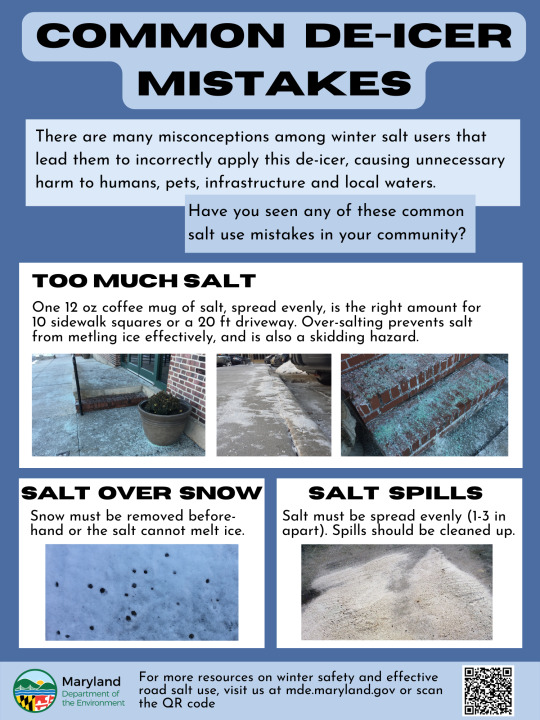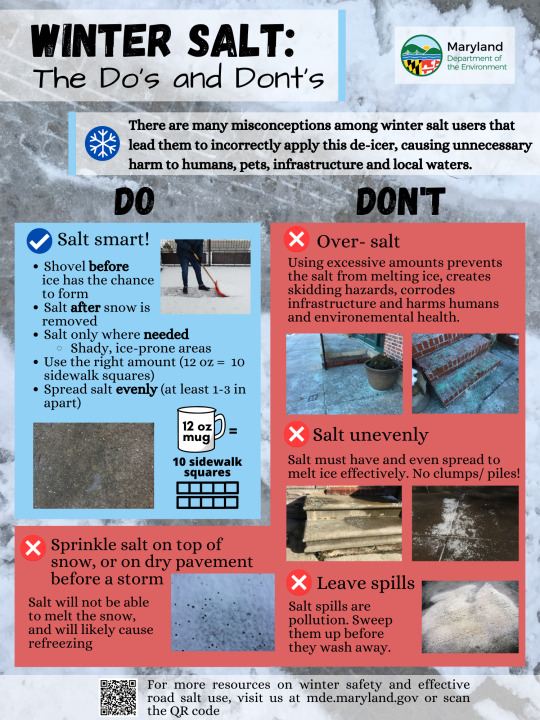#Winter Safety
Explore tagged Tumblr posts
Text

The shift from fall to winter conditions happens quickly on Mount Rainier. Paradise and other subalpine areas have already seen some snow, and more is likely this weekend. When visiting, plan ahead and remember you are responsible for your safety.
Before leaving home, check the current trail conditions and heed local weather forecasts, realizing weather can change for the worse in a very short period of time. Before starting your hike, stop by the Longmire Museum or Jackson Visitor Center in the southwest part of the park, or the Carbon River Ranger Station in the northwest, for the latest trail conditions. Note: While SR410/123 on the east side of the park are still open, all eastside visitor facilities have closed for the season.
Always carry survival gear with you in case you have to spend the night out, including the 10 Essentials: food, water, warm clothing, emergency shelter, stove/fuel, flashlight, avalanche transceiver/probe/shovel, map/compass/GPS, first aide kit, & repair kit for any equipment.
Wear footwear with good tread to minimize risks from slipping. Consider using traction devices like shoe chains or hiking poles for extra stability.
You may need a reliable map and compass skills to traverse snow-covered trails, which can be difficult to follow, particularly in backcountry areas.
Know your limits. Know your experience and ability to survive in an alpine environment and don’t exceed them. A trail that is easy in summer can be challenging in winter.
Find more safety tips at https://go.nps.gov/MORAWinterSafety
NPS Photo of snow on the Tatoosh Range, 10/23/24.
36 notes
·
View notes
Text
snow advice for florida boy who moved to wisocnsin and has 0 snow experience ?? today was my first time seeing it :o and i am trying to look stuff up but idek what to consider and worry about bc i havent had a chance to run into issues yet or grow up with it knowing what to do for certain things
like ice in dangerous spots like stairs? is it polite or rude to clear all the snow off the balcony thing outside our second story appartments and the stairs ? is it rude to leave a little snow guy on the balcony thing railing ? any advice??? google is so unhelpful for this it just keeps suggesting ppl asking about how many ppl havent seen snow or if it doesnt snow some places or a story about someone seeing snow for the first time and no Basic Beginner Advice for someone who knows nothing but i am scared of cold and layering is important
any advice is welcome please pls pls !!!
18 notes
·
View notes
Photo

Winter's Silent Seekers: A Gentle Reminder to Share the Warmth Safely
11 notes
·
View notes
Note
Hey Mama, are you doing okay????? In class today we were looking at polar vortex in North America rn and one of the places my teacher talked about was the province i think you live in (you're Canadian, right???) and he said it was like -40 Degrees Celsius there!!!!! I don't even know how to comprehend those temperatures!!!! Like, are you still alive out there???
Hello my sweet summer child! <3 You're right, I am Canadian! And im not going to lie to you, its been rough out here. And more importantly, its been CONSISENTLY COLDER THAN THE SURFACE OF MARS HERE.
My area of the province has set several temperature records in the past few days:
January 14, 2024: New record of -45.1, Old record of -41.6 set in 2020
January 13, 2024: New record of -45.3, Old record of -41.7 set in 1972
January 12, 2024: New record of -45.9, Old record of -39.4 set in 1969
This doesn't account for the Windchill factor which effectively made the temperatures closer to -55 degrees or colder. To put it into context the only way I can think to, According to Environment Canada at:
-28 to -39 degrees Celsius exposed skin can freeze in 10-30 minutes.
-40 to -47 degrees Celsius exposed skin can freeze in 5-10 minutes.
-48 to -54 degrees Celsius exposed skin can freeze in 2-5 minutes.
Literally not a single car in my family's worked, no matter what we did. This is including extended family, so like, 13 cars. Its just too damn cold for them. Hospitals were literally wrapping their ambulances with heated blankets in between calls so that the entire engine wouldn't freeze. In their heated garage.
Its about an eight day wait for any kind of towing or boosting services. From any provider.
We out here, we cant see anything through the ice fog because the air itself is frozen, but we out here.
Also, I feel like this is the perfect opportunity to give the rest of you much farther south than me tips for surviving other wandering polar vortex's in the future, because at least we're prepared up here:
YOU NEED SURVIVAL EQUPMENT IN YOUR CAR!!! I CANNOT STRESS THIS ENOUGH!!!! I'm talking heavy duty gloves, hats, socks, blankets, those heat reflective thermal blankets. If possible, have enough for at least two people but if you're a family ensure there's clothes for every member of your family. I also highly recommend that you get hand and feet warmers to put into your boots and gloves to prevent frostbite
Here is a good checklist to keep, and is very similar to what I have in my car:
https://todayshomeowner.com/weather/guides/winter-survival-kit-for-your-vehicle/
On that note, dressing for seriously cold weather is no fucking joke either, okay? There's an art to it, and that art is L A Y E R S . More layers than you think you need, and then one more. If you can bend your arms or legs without struggling at least a little bit, put another sweater on, underneath your windproof thick outer layer. And another pair of socks. Never leave the house without a hat and your ears covered.
Here's a good guide, which includes the warning signs, symptoms, and suggested actions for each stage of frostbite and hypothermia. Which, in case you didn't know happen in three stages of severity similar to burns but on the opposite side of the temperature scale.
Sorry to turn this into a Winter Weather Safety PSA but I genuinely cannot stress enough how important it is to be prepared in extreme cold. And please, for the love of everything good on this earth, do not and do not let your friends or anyone else walk anywhere when they've been drinking. Do. Not.
Every year in my city at LEAST several collage kids freeze to death because "their place isn't that far" "I have a good jacket." "Ive done it before."
People have frozen to death outside bars because they fell in a snowbank and were too drunk to get out and nobody saw them, because they tried to walk home.
Anyways, stay safe (and warm) out there everyone!!!!
#answered asks#haleigh speaks#not tolkien#but very important!!!!!#winter safety#winter safety tips#extreme cold#I'm from northern Canada okay i know what I'm talking about#polar vortex
16 notes
·
View notes
Text
To anyone experiencing the current wind and ice storm, please stay safe and warm! Layers and insulated rooms are your best friends if power/heat are lost, and if you're driving and start to slide, put your car in neutral immediately and don't slam on your breaks.
Love,
Team Dotarch

#gaming#mc#mc servers#minecraft#minecraft servers#minecraft smp#heatpatsgavals#ice storm#winter safety#safety#LGBTQIA+
3 notes
·
View notes
Text
A quick winter safety PSA
It’s that time of year folks. If you’re shoveling sidewalks and using ice melt this winter, please remember:


Also don’t believe what the package says about being environmentally safe or pet friendly. That’s just marketing. Ice melt is a chemical and it will poison pets, erode infrastructure, and pollute freshwater habitats. We should still use it bc it’s an important winter safety tool. But there’s a right way and a wrong way to do it.
#winter tips#road salt#salt#winter safety#snow#weather#ice#environment#life hacks#tmyk#eco friendly#snow day#epa#pollution#health and wellness#safety tips
3 notes
·
View notes
Text
❄️ Stay Safe This Winter! 🧤 Learn essential tips to protect yourself from icy hazards, hypothermia, frostbite, and more in this free health and safety course. Master the skills to navigate winter weather like a pro! 🌨️
#how to be safe during winter#frostbite#hypothermia#baby it's cold outside#winter safety#stay warm#protect yourself#navigate winter weather#cold season#healthy lifestyle#health tips#healthy and happy#safe and sound#take care of yourself
0 notes
Text
Christmas Countdown Poem 2024: 5. Watch Your Feet
🧊 "As the ice grows like sheets on the ground outside..." A playful reminder to tread carefully this winter, brought to you by Pesky Poetry! #WinterHumour #ChristmasPoetry #PeskyPoetry
As the ice grows like sheets,On the ground outside,Make sure to keep upright,And watch how you stride.***One misteppen foot,A wrongly placed boot,Could see your caboose,Go down with a boop.***So watch your feet,Don't rush on your toes,Try to stay upright,As you walk in the cold. 🚀 Help Spread the Poetic Magic! Your share can brighten a poet’s day. 🌟 Click to share this poem on Facebook or X.com,…
0 notes
Text
“I prefer winter and fall, when you feel the bone structure of the landscape. Something waits beneath it; the whole story doesn’t show.” – Andrew Wyeth
Winter lasts a long time in the higher elevations of the national park. Snow can cover the subalpine meadows into July. These long lasting, deep snows write amazing stories on the landscape. They also mean learning how to keep yourself and your friends and family safe.

How do you learn about being safe while having fun in the snow?
Do you have friends who are snow-savvy and showed you the ropes?

Did you take a class or two? Maybe from an outdoor community group or specialists like Northwest Avalanche Center?
What is your favorite source of winter and safety intel?

Park information on winter safety can be found here https://www.nps.gov/mora/planyourvisit/winter-safety.htm Information on the 10 Essentials can be found on this website https://www.nps.gov/articles/10essentials.htm Northwest Avalanche Center is at Home - Northwest Avalanche Center (nwac.us)
These photos are from years past and do not reflect current conditions. NPS Photo. Snow dusted Longmire parking and sidewalks with cars and building in background. December 2018. NPS Photo. Edith Basin blanketed in snow. Ski tracks crossing the snow leading up towards a ridge. January 2014. NPS Photo. View looking over a snowbank on the road to Paradise up to Mount Rainier with a lenticular cloud over the summit. January 2018.
19 notes
·
View notes
Text
and don't forget to keep extra blankets and jackets/clothes in your vehicle if you have to travel
COLD WEATHER TIPS FROM SOMEONE WHO LIVES WHERE IT’S COLD:
I always see posts about layering clothing, but there are so many more creative ways to help keep you warm if you don’t have a lot of warm clothes. But first, a note on layering clothing:
-Your underlayer is your WICKING layer. That means it is a layer specifically to absorb the moisture your body produces. DO NOT USE COTTON AS A BOTTOM LAYER. Use merino wool if possible, but other good substitutions are nylon, polyester and rayon.
-Your middle layer is for insulation. You want AIR POCKETS in there, NOT tight fitting clothes. This is where you want to put your fluffy sweaters, your fleece, down, fur, flannel, or vests. If you do not have these, you can substitute with multiple layers of long sleeve shirts.
-Your outer layer is for keeping the cold away from your body. If you do not have a jacket, you can put on your thickest piece of clothing and then a raincoat over it. Windbreaker if you have one.
ALSO
-Jeans are the absolute worst at holding heat. Use only as a last resort.
-You can’t really ever have too many layers on your feet. Alternate tucking your layers of pants into your layers of socks to keep your ankles warm!
-Wear a hat OVER a hood if it will fit! This will keep your ears warmest.
TAKE OFF/OUT ANY AND ALL JEWELERY/PIERCINGS
-If you have a medical bracelet, DO NOT REMOVE IT. If you can, tuck a layer of clothes between it and your skin.
NON-CLOTHING TIPS:
-Raid your recycling. Gather all cardboard boxes and break them down so that they are flat. Put them on the floor to add more layers between you and the cooling house. Newspaper will also serve the same purpose.
-In an emergency, you can also layer newspaper between clothing layers. Don’t worry about looking stupid if you’re staying warm.
-If you have a tent, set that sucker up in whatever room you have decided to stay in. Stay in it and keep it zipped shut as much as you can, but do NOT cover the vent at the top. You can put the rain fly up, but make sure there is circulating air for you to breathe.
-You are probably not going to feel very hungry at times. DO NOT STOP EATING OR DRINKING. Digestion produces a lot of body heat and the food will give your body energy to keep itself going.
-The best foods are heavy and full of carbs and proteins. Eat nuts, eggs, pasta, meats, and beans. If you are on a diet, now you’re not. If you’re vegetarian… bulk up on those pastas and nuts.
-Try not to sweat. If you are finding yourself getting damp, take off the outer layer just until you start to cool slightly. Then redress! Your bottom layer should dry quickly, and being wet is dangerous.
-On that note, STAY ACTIVE. You are probably going to want to hunker down and snuggle up, but that will make your muscles cramp. Every 15-20 minutes do something that gets you up and about. Walk circles in the room, do a couple jumping jacks, stretch, whatever. Just enough to move some blood around your body. Don’t get sweaty or out of breath, it’s just a little movement.
-CHAPSTICK. ON YOUR LIPS. ON YOUR NOSE. ON YOUR EARS. ON YOUR KNUCKLES. Don’t let your extremities get dry or cracked.
SIGNS OF HYPOTHERMIA:
-Uncontrollable shivering -Slurred speech -Confusion or memory loss -Dizziness or lack of coordination -Inability to be woken from sleep
CHILDREN AND INFANTS!!!! I CANNOT STRESS THIS ENOUGH.
-Children WILL get colder before you. Make sure they are properly bundled up.
-If you need to breastfeed, put a blanket over the both of you and wait a few minutes for the air to warm before removing or shifting your clothing.
-DO NOT COVER AN INFANTS FACE. ESPECIALLY WHEN SLEEPING. Keep them tucked inside your own clothes when possible. As close to your heart and stomach as possible.
-Put chapstick on children’s cheeks and clean their face often if they are crying or wiping at their nose. This will prevent cracked skin and irritation.
-Make sure your children are staying as hydrated as you! They are going to fuss and not want to drink cold things, but they NEED liquids.
SIGNS OF HYPOTHERMIA IN INFANTS AND TODDLERS ARE DIFFERENT:
-Shortness of breath -Cold, red skin -Lethargy or listlessness
Finally:
CHECK ON YOUR NEIGHBORS. CHECK ON CHILDREN. CHECK ON THE ELDERLY. STAY SNUGGLED. STAY SAFE.
71K notes
·
View notes
Text
Why Your Tongue Sticks to a Metal Pole in Winter and How to Free It
In winter, some people, either playfully or unknowingly, stick their tongue to a metal pole, which can be dangerous. However, not everyone understands the scientific reasons behind it. In this article, we will explore why the tongue sticks to metal, the science behind it, and how to free yourself from this situation.
youtube
Scientific Reasons Behind Tongue Sticking to a Metal Pole in Winter
During winter, the air is dry and cold, and metal poles cool down quickly. When you touch a cold metal surface with your warm, moist tongue, the saliva on your tongue freezes almost instantly. This happens because the metal pole absorbs heat from your tongue so quickly that your body cannot replace the heat fast enough.
The saliva on your tongue quickly turns to ice, which causes your tongue to get stuck to the metal. This is not only uncomfortable but can also harm your tongue if you don't take immediate and proper action.
How to Free Your Tongue if It Gets Stuck
If your tongue gets stuck to a metal pole, don't panic. A simple solution is to use warm water or any other liquid. By pouring warm water between the metal and your tongue, the frozen saliva will gradually melt, and you can easily free your tongue. However, make sure not to use excessively hot water, as it can burn your tongue.
How to Prevent Your Tongue From Getting Stuck to a Metal Pole
Stay Cautious: Never place your tongue on any metal object during winter, not even as a joke.
Educate Children: Children may be curious about this phenomenon, so it's important to make them aware of the dangers.
Avoid Metal Objects: During winter, avoid touching outdoor metal objects like poles and railings, as they cool down rapidly and have a high capacity to absorb heat.
Conclusion
Sticking your tongue to a metal pole in winter is a hazardous situation. It primarily happens when your warm, moist tongue touches cold metal, and the metal quickly absorbs the heat from your tongue, causing the saliva to freeze. To avoid such situations, it’s essential to stay cautious. However, if it does happen, using warm water or liquid to melt the ice can help you free your tongue. Staying calm and taking quick, proper action can save you from injury.
Watch More: Why Are There No Great White Sharks in Any Aquarium?
Tags: metal pole in winter, tongue sticking, winter dangers, tongue stuck to metal, winter hazards, cold metal, metal heat absorption, winter metal pole dangers, tongue freezing, saliva freezing, winter safety, metal pole and tongue, tongue stuck to metal what to do, freezing metal in winter, heat absorption in cold metal, tongue freezing in winter, cold weather safety, preventing tongue sticking, dangers of cold metal, tongue stuck in winter
#metal pole in winter#tongue sticking#winter dangers#tongue stuck to metal#winter hazards#cold metal#metal heat absorption#winter metal pole dangers#tongue freezing#saliva freezing#winter safety#metal pole and tongue#tongue stuck to metal what to do#freezing metal in winter#heat absorption in cold metal#tongue freezing in winter#cold weather safety#preventing tongue sticking#dangers of cold metal#tongue stuck in winter#Youtube
0 notes
Text
As the winter season approaches, construction companies, including those offering demolition services in Brooklyn Park, Minnesota, must gear up for the challenges posed by colder temperatures and inclement weather. Preparation is essential to ensure that projects can proceed smoothly despite the harsh conditions, making it imperative to have a comprehensive checklist in place.
0 notes
Text
Example #7,425 of why they say "safety rules are written in blood."
NOTE: what follows only is about USA circumstances.
I had this (nearly) happen with a desk lamp plugged into a cheap power strip. (Not even a high-wattage appliance like a space heater.) Fortunately I saw the plastic on the power strip starting to discolor from what turned out to be a poor connection between the lamp plug and the power strip, so I caught it before it got to the point of actually catching fire.
Most inexpensive power strips are manufactured by companies whose primary goal is maximum profit and minimum engineering. Also, some manufacturers in China will fraudulently label a product as being UL compliant (the lab that is supposed to test for electrical safety in the US). These manufacturers use the smallest wire possible (smaller wire heats up faster), cheaper materials, and poorly engineered components and connections. Basically they don't care if your home burns because the likelihood that they'll be held accountable is minuscule.

37K notes
·
View notes
Text
Saturday
. Today is a brand new day. If you think, “it’s just another day” your life will simply e stagnant and unchanging. You are in fact given this unique day, unlike any other, so live it to the fullest. Perfect Liberty 2017.3 I like to think of myself as always being creative and able to adapt. Surprise, I uses and avatar to navigate and get around in a virtual world. Over the years, she has…

View On WordPress
0 notes
Text
Winter Construction
Winter construction poses unique challenges, making it essential to address specific safety and operational concerns. This article explores the crucial aspects of winter construction, focusing on how to effectively navigate its complexities while prioritizing safety. Understanding the Risks in Winter Construction Winter construction presents unique challenges that significantly impact both the…

View On WordPress
#cold weather construction#construction equipment#construction industry#construction management#construction planning#construction site safety#construction technology#Risk Management#safety measures#Safety Training#weather tracking#Winter construction#winter hazards#winter safety#Worker Safety
0 notes